Creating effective project requirements requires a thorough process. It starts with gathering stakeholder, business, and technical requirements. In this article, we’ll show you how to form a complete project requirements document with data from interviews, surveys and conversations.
Why you need project requirements
Understanding the importance of project requirements is crucial for any project’s success. A project requirements document outlines the project’s goals and scope. It serves as a guide as the project progresses and the risk for miscommunication between your internal team, clients and yourself grows.
Taking the time to document and create this document will save you time down the line and ensure your project stays on track.
The role of project requirements in successful project management
A project manager’s success depends on the clear definition of project requirements. These requirements are listed in the document, along with the function and non-functional expectations of the result.
Managing expectations is key to keep the client and your team aligned with the project’s scope and goals. Creative a traceability matrix helps to match solution requirements with their goals, so that all needs are met during the execution phase.
The impact of well-defined requirements on your project's outcomes
Well-defined requirements have a strong influence on your project results. They make project management smoother and provide clarity on what is expected. This clarity sets the stage for smooth project execution.
To summarize, clear requirements have a direct impact on project delivery, benefit all stakeholder, cutdown on last minute obstacles, help with planning and boost chances of project success.
How to define effective project requirements: a step by step guide
To ensure a successful project, it's critical to have a well-defined set of requirements, a dedicated team and a thorough understanding of procedures. An extensive knowledge in creating a process map can greatly influence the project's overall efficiency. This method allows you to visualize complex processes which in turn can streamline project implementation and improve collaboration.
Use requirements elicitation to gather all necessary information, ensuring it aligns with your project scope. Apply requirements management techniques to handle changes and maintain control. Finally, prepare a requirements traceability matrix to track the requirements throughout the project life. Proper requirements documentation is vital in this process.
The ingredients to an effective project requirements document are a set of goals, a dedicated team and a thorough process.
Creating a process map can positively influence the project's overall efficiency. This method allows you to visualize complex processes which in turn can streamline project implementation and improve collaboration.
The key information to include in your project requirements are:
- Business needs and stakeholder expectations
- Clear and measurable objectives
- Project scope
- Timeframe and budget constraints
Step 1: Identify stakeholders and their needs
In any project, stakeholders are crucial and contribute significantly to the project requirements document and project scope.
Their needs combine business requirements, technical requirements, functional requirements, non-functional requirements, and solution requirements. Understanding all of these facilitates the achievement of project objectives.
Here are good places to start better understanding the needs of your stakeholders:
- Refer back to your statement of work
- Internal conversations, or even recordings of video calls with clients
- Surveys and questionnaires, for example client intake forms
All this data will help you form a bigger picture of what the project requirements are, and ensure you’re not missing anything important as you start to document them.
Step 2: Set clear and measurable objectives
Once you start having a clearer idea of what the stakeholder needs are, it’s time to set up clear and measurable objectives.
During this step, you should be answering: based on the project requirements, what can you team realistically achieve and what should the stakeholders’ expectations be?
Step 3: Create a detailed project scope
The scope outlines the objectives, deliverables and list of what is to be included and excluded in the project. Outline stakeholder and business requirements and a comprehensive overview of project demands and expectations.
This document is key in maintaining clarity and direction for everyone involved throughout the project's progression.

Step 4: Establish timeframes and budget constraints
Practical timeframes and budget restrictions should be clearly stated in the project requirements document. Outlining these clearly is a great way to ensure you’re managing expectations efficiently on all sides.
As you plan for your project, you can start tracking against a clear budget taken directly from your project requirement document and ensure you’re delivery not online on time but also within budget. No unexpected costs or timeline changes!

Best practices for documenting project requirements
Through all your conversations you’ll gather a lot of requirements and data. The best way to make good use of these is by actually documenting them and making them clear, readable and accessible to all relevant stakeholders.
Project managers generally use documentation tools. You could also consider putting together a project requirements document in Bonsai for your clients and team to sign off on.
Consistent language and terminology
The best way to keep a project requirement document accessible is through consistent language and terminology. Any stakeholder should be able to easily understand the document.
This rule of thumb ensures that everyone can understand scope goals and deliverables. It’s a great way to prevent miscommunication, confusion and project delays.
Keep documentation simple and understandable
Consistency is important, and so is being concise and simple. Avoid technical jargon and abbreviations. Avoid lengthy sentences. Keep it short and clear for all.
How to manage project requirements
Now that you’ve got your project requirements document, it’s time to manage those throughout the project.
The role of a project manager is to take the project requirements document and turn it into a well-oiled machine throughout the duration of the project.
There are many ways you can manage project requirements, which we outline below.
Turn the project requirements into a plan
You know what is expected, now it’s time to plan how you’ll get there. Turn the requirements into a clearly defined plan with actionable tasks, task owners, deadlines, prioritization and more.
Using a project management software like Bonsai makes this phase much easier as you can align with your team and keep your client updated on progress. You can also track the time you’re spending on all of these tasks to ensure you’re following the budget and timeline constraints laid out in the project requirements document.
.png)
Monitor and track
Once your plan and tasks start to be in the execution phase, you need to keep a close eye on how everything progresses. Project managers need an easy way to monitor and track that project requirements are met as agreed. They also need to be able to report back to Stakeholders easily.
Again, if you’re using a project management software like Bonsai you’re able to easily keep tabs on tasks that are behind, budget spend, deadlines, and more. If you’re going to go above budget, Bonsai will let you know and keep you on track.
Report to main stakeholders
As the project progresses, it should be simple for stakeholders—whether that’s the client, managers, employees—understand how things are advancing based on the agreed project requirements.
Documenting not only the project requirements ahead of time, but also how the project progresses, is a great way to ensure transparency, keep everyone in the loop and avoid possible miscommunication.
Common challenges in defining and documenting project requirements
Defining and documenting project requirements can be quite challenging. One major hurdle is identification of all stakeholder requirements. Stakeholders often have diverse needs and expectations that can be hard to align with the project objectives. This issue bleeds into project management, where the project team struggles to translate vague or complex business needs into specific, actionable tasks.
In addition, the process of requirements documentation is often complicated by miscommunication between technical and non-technical stakeholders, particularly when outlining technical and functional requirements.
Below we provide tips on how to overcome these possible challenges.
Vague or incomplete requirements
The best way to avoid vague or incomplete requirements is to spend a lot of time upfront to create the project requirements document. Do multiple rounds of feedback, get everyone involved. Ensure no detail slips through the cracks so that when it’s time to create actionable tasks, project managers have all information needed at their disposal.
Changes in project requirements
A plan, no matter how well thought out, doesn’t always go according to plan. It’s important to be prepared for this. A good project requirements document also outlines scenarios where projects are delayed or don’t go exactly as intended.
By weighing these options ahead of time, they are less stressful and time-consuming to deal with than if they feel totally unexpected. A project requirements document can equip you with unexpected changes of budget, timeline, resources, client needs and more.
As the project progress, your team should keep it up to date with changes or updates so that everyone is aligned on what is happening.
Stakeholder misalignment on project requirements
Stakeholder agreement on project requirements is essential for a project's success. One risk is that stakeholders don't fully align on the requirements, hindering the project's progress along the way. It's crucial to ensure alignment and agreement for all business, technical, functional, or non-functional requirements.
A requirements management plan that includes a requirements traceability matrix aids in managing and tracking the project scope and objectives. The project requirement analysis validates these requirements ensuring their alignment with the overall business strategy and solution requirements.
Case studies: Successful project requirement definition and documentation
A major software development initiative’s success depends on a well-crafted project requirements document. And below are good examples of how good requirements management can lead to growth.
The role of requirements management
The following cases highlight the significance of requirements management. In each example, a comprehensive plan for managing requirements is developed. This setup facilitated effective analysis of project requirements, ensuring they were in sync with the project’s scope and objectives.
Stakeholder requirements were also meticulously documented, and all technical necessities were clearly outlined, providing a transparent solution to the requirements. These steps were instrumental in each projects' smooth execution and ultimate success.
How Google defines and documents project requirements
Google approaches project requirements definition and documentation with a methodical requirement analysis, capturing all stakeholder and business requirements. This involves a thorough requirements elicitation process, refining the project’s scope, and establishing clear objectives. The information gathered is then organized into a structured project requirements document.
This document encompasses technical, functional, and non-functional requirements, all managed via a detailed requirements management plan. To ensure thoroughness and traceability, a requirements traceability matrix is utilized, linking project requirements with solution requirements.
Project requirement practices at Amazon
Amazon adheres to strict project requirement practices to maintain efficiency and effectiveness. The project requirements document integrates stakeholder and business requirements, delineating the project’s scope and objectives to maintain a clear path to execution.
The document also specifies technical, functional, and non-functional requirements. The process includes steps such as requirements elicitation and documentation. A requirements management plan, supported by a requirements traceability matrix, facilitates proper management of requirements.
In conclusion, these practices culminate in a definitive strategy for solution requirements after a comprehensive analysis of project requirements.
Conclusion: The key to successful project management
In conclusion, the key to successful project management lies heavily in requirement elicitation and management. This involves thorough project requirement analysis, where the business, technical, functional, and non-functional requirements are identified and articulated in a project requirements document.
The project scope and objectives should align with the stakeholder requirements. The entire process should be documented in a requirements management plan and a requirements traceability matrix, ensuring solution requirements are met. This meticulous approach ensures a well-aligned and clear pathway to project success.







